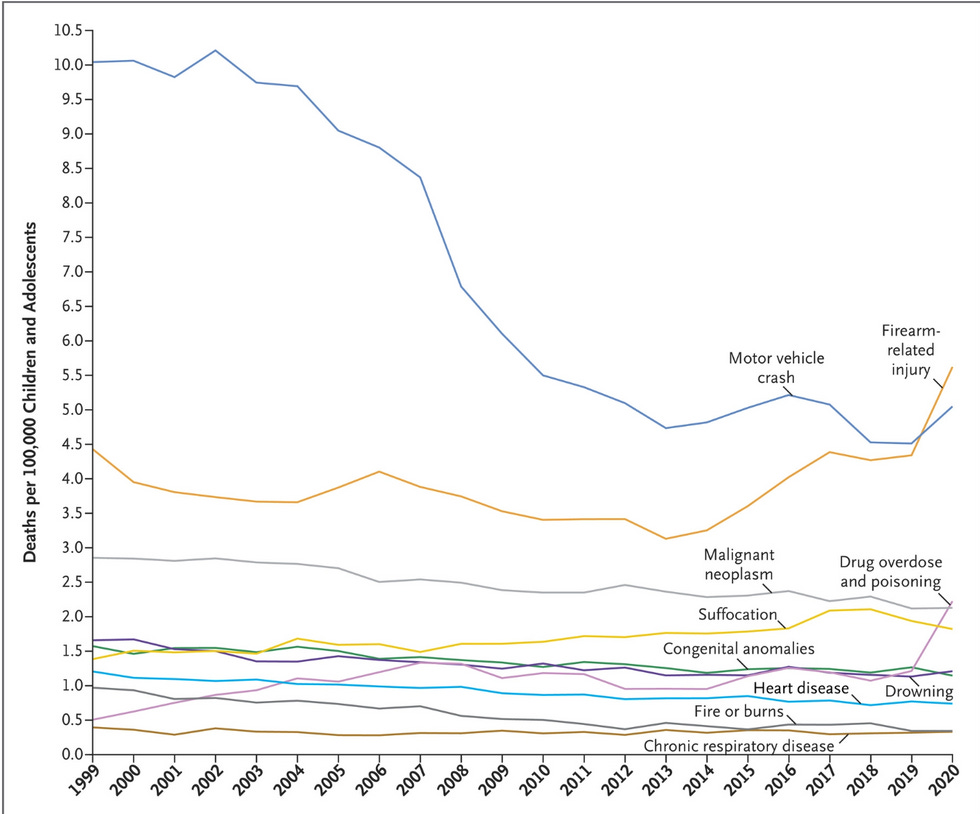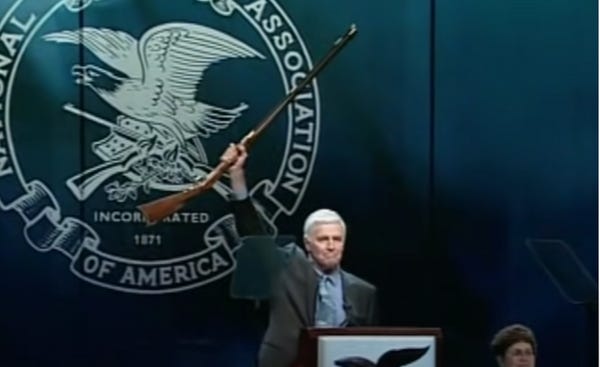More Kids Being Killed By Firearms Than Literally Anything Else Now
It used to be car accidents, but cars got safer. Guns did not.
Congratulations, gun nuts! According to a research letter published by the New England Journal of Medicine, children are now being killed by firearms more than anything else, supplanting car accidents, which have been the number one killer of kids for decades now.
The bright side here is that deaths in car accidents have increasingly gone down over the years as car manufacturers have sought to make them safer. The downside is that, as car accidents have gone down, gun violence has gone way up. So have "drug overdoses and accidental poisonings," which are now the third most common cause of death, perhaps because of the surge in accidental poisonings during the pandemic.

Via NEJM:
The previous analysis, which examined data through 2016, showed that firearm-related injuries were second only to motor vehicle crashes (both traffic-related and nontraffic-related) as the leading cause of death among children and adolescents, defined as persons 1 to 19 years of age. Since 2016, that gap has narrowed, and in 2020, firearm-related injuries became the leading cause of death in that age group ( Figure 1 ). From 2019 to 2020, the relative increase in the rate of firearm-related deaths of all types (suicide, homicide, unintentional, and undetermined) among children and adolescents was 29.5% — more than twice as high as the relative increase in the general population. The increase was seen across most demographic characteristics and types of firearm-related death.
Perhaps if we referred to this as an increase in "post-birth abortions," we could get conservatives to care, but probably not.
Patrick Carter, an author of the research letter, explained to NPR, "Firearm deaths we haven't made much progress on, in fact it increased in recent years. And we have had a decrease in motor vehicle deaths."
"We can do the same thing with firearms. We just haven't been able to do that in the same amount of years yet," he continued. "It takes time to figure out what the underlying issues are with the problem and then finding the solutions."
Except the thing is, we can't. We literally cannot do that. Support for gun control is at its lowest point in years, down to 52 percent, and politicians either didn't want to or were too scared to do anything about it when it was a whole lot higher. If this pandemic has taught us anything, it is that a very large percentage of Americans would rather other people die than be inconvenienced in any way.
Hell, the CDC has been effectively barred from even studying gun violence since 1996. It did a study showing that (obviously) guns in the home increased people's risk of being murdered by a family member, and that just really hurt the NRA's feelings. The US government felt bad for the NRA and passed the Dickey Amendment, a rule in an appropriations bill requiring that “none of the funds made available for injury prevention and control at the Centers for Disease Control and Prevention may be used to advocate or promote gun control.”
Things are starting to let up a little bit. For the first time since 1996, the CDC was given $25 million in 2020 to study gun deaths and injuries. In 2021, one scientist was even given funding to do a study "underlying the association of firearms availability and vulnerability to suicide," and the CDC has given out a few other grants for gun injury prevention studies. Still, we could have a million studies about how much more likely people are to successfully commit suicide if there is a gun in the home ( eight times higher for men, 35 times higher for women, as of the most recent data), and you will still hear people crying, "You can have my guns when you pry them from my cold dead hands!"
And given those statistics, that literal scenario is not entirely out of the question.
One thing to remember, however, is that many Americans didn't even want safer cars in the beginning. They were particularly upset about having to wear seatbelts, which they felt infringed upon their freedom to fly through their own windshields. It took a long time for people to get used to, and now they very much enjoy not dying in car accidents. So it is possible for people to change their minds on these things, but it takes a good long while. Unsafe At Any Speed came out in 1965, and it wasn't until 1996 that all states but New Hampshire had seatbelt laws (it still does not require drivers or passengers over 18 to wear them).
So people do get used to these things. Very few people today consider "not wearing a seatbelt" to be a glorious expression of their personal freedoms, or even really give a shit. If we had reasonable gun control laws, people would get used to that too, and consider a downturn in school shootings, suicides and intra-family homicides to be as much of a luxury as front and side airbags.
[ New England Journal of Medicine ]
Do your Amazon shopping through this link, because reasons .
Wonkette is independent and fully funded by readers like you. Click below to tip us!



